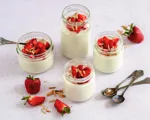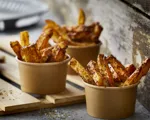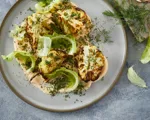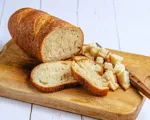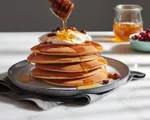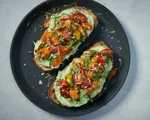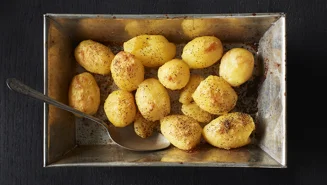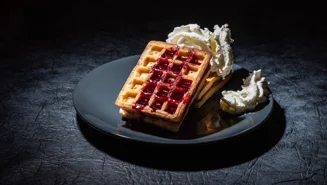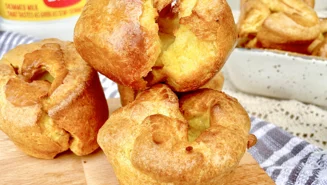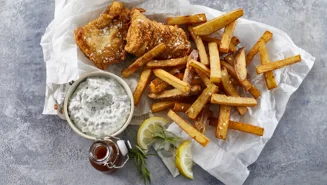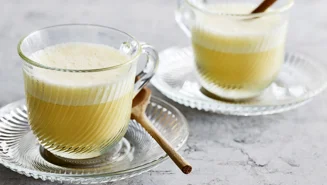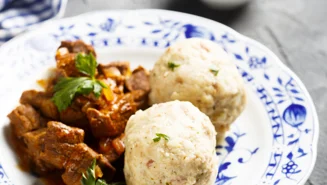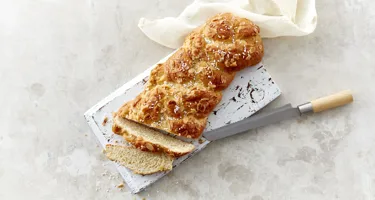
Easter brings families together around festive dinner tables, and Easter bread is a big part of this. Whether enjoyed in its simplest form with spreads or as part of a more elaborate dish, it brings warmth and flavour to the meal. We have a few suggestions for you: from the sweet and spiced to the savoury and traditional, these Easter bread recipes are sure to inspire and add a special touch to your holiday gatherings.
Find your favourite Easter bread recipe
There are as many types of Easter bread as there are ways of celebrating the season − gathering for brunch, lunch, or dinner, celebrating with a big crowd of family and friends or simply with a selected few, or taking either a traditional approach or being a bit more creative with the menu. We gathered some recipes with a little bit of everything so you can find the best ones for your Easter table.
Easter buns
These delightful Easter cream buns are inspired by the Swedish semlor. They consist of a soft, sweet bun filled with marzipan, cream, and lemon zest and are topped with fluffy whipped cream, tangy lemon curd, and a sprinkle of pistachio nuts and dragée Easter eggs. As a finishing touch, they are decorated with beautiful, edible flowers.
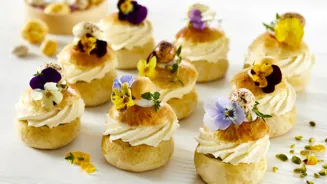
Rose bread rolls
Creatively shaped rose bread rolls are a delicious and impressive way to elevate your homemade bread selection. With a soft and fluffy texture, these rolls are adorned with a simple rose pattern on top and a mix of colourful seeds. They are perfect for breakfast, as a snack, or as a side to an Easter menu, and can be served with a range of toppings and spreads.
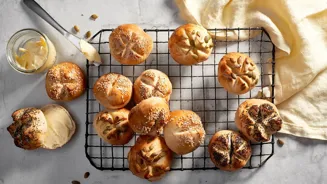
Hot cross buns
Perhaps one of the most common Easter breads, these hot cross buns are a traditional English Easter treat dating back to the 12th century. They are fruity from dried cranberries and raisins, subtly sweet, and contain a delicious spice blend with cinnamon and ginger. These buns were once considered too special to be eaten every day and were limited to important holidays, so whip up a batch for Easter, although we promise we will not tell if you enjoy them all year round.
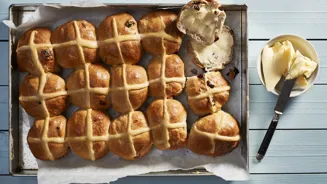
Easter bread nests with baked eggs
Looking for a delicious and creative breakfast idea for Easter? Try making Easter bread nests with baked eggs. These nests are made from light and airy dough with cottage cheese, chives, and parsley. A raw egg is placed in the nest during baking, turning it into a perfectly soft-boiled egg for serving. Baking the eggs in the nest makes the serving fun and different from the ordinary soft-boiled eggs, but the result is just as delicious. It is perfect for a festive Easter breakfast or a weekend brunch with friends and family.
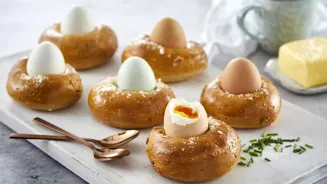
Carrot bread
Try our classic carrot bread − a moist and appetising bread that blends the sweetness of carrots with the nutty crunch of sunflower seeds. It is easy to make and perfect for breakfasts, snacks, or as a side dish for dinner. Decorated with sunflower seeds, each slice has a subtle crunchiness that enhances the flavour.
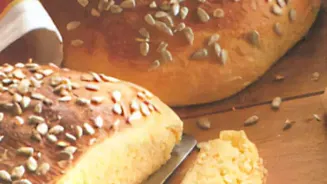
Bread plait
This intricately shaped Easter bread plait is a traditional festive bread that is as delicious as it is beautiful. It is a sweet, buttery dough plaited into a beautiful plait and baked to golden perfection. The bread plait is brushed with beaten egg and sprinkled with pearl sugar and almond flakes for a delightful crunch and sweetness. Serve this freshly baked bread with butter for a heartwarming treat that is perfect for Easter gatherings or a special breakfast.
How to eat Easter bread
Easter bread can be enjoyed in various ways, depending on the type. Sweet bread like semlor or hot cross buns are delicious with a cup of tea or coffee, making for a delightful Easter morning breakfast or afternoon snack. Savoury options are perfect as a part of your Easter brunch or dinner, offering a flavourful addition perfect for soaking up gravies and sauces or for enjoying with salads. Also, rich, savoury bread complements traditional Easter dishes like lamb, ham, or roast chicken very well. Instead of enjoying it as part of the menu, you can experiment with spreads to put on top, pairing your Easter breads with flavoured butter, cream cheese spreads, or the like. You can also serve either savoury or sweet Easter bread as a flavourful element to a charcuterie or cheese board. Its sweetness or savouriness and texture can complement a variety of cheeses, meats, and fruits. If you are celebrating Easter as a guest, Easter bread is a thoughtful homemade gift. Wrap a loaf in a decorative towel or place it in a basket with other Easter treats to share the joy of the season with neighbours, friends, and family. If you need inspiration for what else to put in your gift basket, have a look at our ideas for Easter muffins and cupcakes. In addition to bread, cupcakes, and muffins, you can add coloured chocolate Easter eggs for a festive touch.
How to store Easter bread
If you enjoy it within a few days, it is best to store Easter bread at room temperature to keep its flavour and texture the best. Wrap it in cling film or place it in a plastic bag. It will keep like this for up to two days. If you need to store it longer, put it in the fridge where it will keep for up to a week. Ensure it is tightly wrapped to prevent it from drying out. Leave it out at room temperature for about 30 minutes or lightly toast it before serving to let it regain its softness and freshness.
Can you freeze Easter bread?
Yes, you can freeze most bread, but it does depend on the type, though. If you make the Easter buns mentioned above, they are not good for freezing after you fill them. Otherwise, it should not be a problem freezing your Easter bread. Wrap the bread or bread rolls tightly in cling film, followed by a layer of aluminium foil, and freeze for up to three months. Thaw at room temperature or in the fridge overnight before serving. This is a great way to enjoy your bread long after Easter has passed, preserving its freshness and good flavour.

